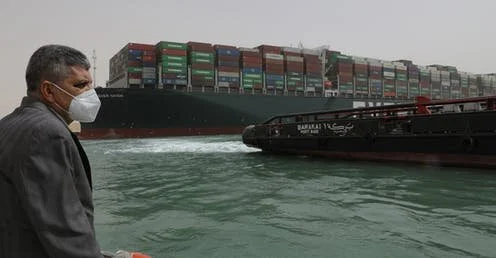Suez Canal Blockage Strains Global Supply Chains
By Nathan Tynan ‘22
Since March 23rd, the Suez Canal has been rendered impassable by a large cargo ship, disrupting global trade. The crisis was triggered when the Ever Given, a 1,300-foot-long ship loaded with 20,000 containers became diagonally lodged in the canal, bringing traffic in the waterway to a halt. While Egyptian authorities are working tirelessly to free the Ever Given, attempting to dig the ship out of the canal banks and pull it free with tug boats, it is still not apparent when the passage will be clear, with estimates ranging from days to weeks.
The Suez Canal serves as a vital chokepoint for global trade, making any disruption significant. Under normal circumstances, roughly 12 percent of all global maritime trade is routed through the Suez Canal, comprising approximately 1.17 million tons of cargo in 2020. In particular, the canal is a critical link between Europe and Asia, with the alternative sea route between the two continents going around all of Africa. On a standard day, up to 106 ships pass through the canal, with the closure leaving 320 ships idle, waiting for a resolution.
Already, the impacts of this disruption are being felt. Since the beginning of the crisis, approximately $10 billion in global trade has been impacted every day, coming to a total of over $40 billion so far. In particular, the oil market has been severely affected, with global oil prices rising more than 5% as of March 27th, due to the canal supporting 10% of all maritime oil shipments. Agricultural markets have also suffered, with 8.5% of all grain shipments and 30% of all potassium-based fertilizers flowing through the Suez Canal.
In the near-term, the closure of the canal will result in a surge in prices, particularly in the energy, agricultural, and consumer goods markets, as ships wait for the Ever Given to be freed. Prices will be further impacted by some shipping companies opting to take the long route around Africa, extending shipping times for goods on those ships by a week or more, regardless of when the canal reopens. Along with increasing shipping times, this decision will also lead to greater fuel consumption, further impacting energy markets. While European and Asian markets will be the most affected, the effects will reverberate globally, due to the highly interconnected nature of supply chains.
Although markets will mostly return to normal once the Suez Canal reopens, there may be long-lasting impacts on global trade. When possible, some shipping firms may choose different routes for their cargo, due to reduced confidence in the management of the canal by the Egyptian government. Firms may also opt more generally to reduce their reliance on maritime shipping, employing air or freight when applicable. Thus, the crisis will be a boon to private air cargo and freight firms, along with public projects such as China’s Belt and Road Initiative. Some companies may even opt to eschew global supply chains altogether, attempting to source materials domestically rather than relying on trade networks that have already been disrupted by COVID-19. Though the Suez Canal crisis will likely fade into relative obscurity among laypeople soon after its resolution, it will continue to serve as a cautionary tale of the vulnerabilities of a globalized economy, with its lessons impacting market participants for years to come.
Sources:
https://www.nytimes.com/live/2021/03/27/world/suez-canal-stuck-ship
https://www.wsj.com/articles/egypt-aims-to-refloat-cargo-ship-grounded-in-suez-canal-11616837175


